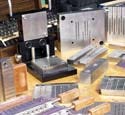Machining for Small Parts
September 13, 2004
OriginallyPublished MPMN September 2004PROFILE
Machining for Small Parts
A supplier of micromachining products provides close tolerances
Susan Wallace
|
Molds from Guidant are machined with Makino equipment. The equipment can help companies decrease lead times. |
Micromanufacturing in the medical field is becoming increasingly common. Intricate, high-tolerance, and high-quality parts, such as the leads that connect to life-saving devices such as implantable defibrillators and pacemakers are being designed ever smaller. Machines to manufacture them have a tough task to fulfill.
Guidant Corp. (St. Paul, MN; www.guidant.com)designs and develops cardiovascular medical products. It is experienced in micromanufacturing technology. This is particularly true at its Model Shop for Advanced Manufacturing Engineering in Cardiac Rhythm Management. The shop has grown at a rate of nearly 46%. It is expected to double in size over the next year.
The model shop's group leader, Susan M. Sackman, says the features and parts they are making in micromanufacturing require such tolerances as 0.0002 in., with absolutely no variance, over as much as a 6-in. flat piece of 420 stainless steel.
To do this, "We have come to depend on vertical milling and sinker EDM machines that can give us the best tolerances possible," Sackman says. "We set out to acquire the best machines possible to meet our demands."
Guidant sent out some test samples to Makino (Mason, OH; www.makino.com)and a number of competitive machine manufacturers to mill and burn some molds. Sackman says the results were not even close.
"The machining industry is putting out great machines, but Makino definitely has distinct advantages over competitors, which makes the decision to buy machines a little bit easier," she says. "We also use high-speed machining for milling fixtures and support tools for general manufacturing production-line assembly devices."
"One thing that we strongly considered was whether the machine will be as effective and productive on our shop floor in two or five years as it is today. When you have an 8000 rpm machine, you are very limited. When you have a Makino that goes 30,000 rpm, like the V33, then your operation can really become efficient. And, because we primarily mill and use copper electrodes, the outstanding EDM part quality produced on the EDGE2S is outstanding--just awesome."
The company purchased two new V33 VMCs from Makino to cut copper electrodes for the EDGE2S Ram EDM machines, which are dedicated to burning lead fixture molds for various products. Guidant also uses the V33s to hard mill steel molds and also small, delicate ceramic leads.
Sackman says, "We need machines like Makino that we can count on to hold tolerances, quality, and surface finishes. We just cannot get that micromanufacturing quality in older technology or other competitive equipment."
"Before we got the Makinos, a mold would historically take us 8 to 10 weeks to build. We are now building them in four," saysSackman. "We ship them to our different Guidant locations, where these molds are used to produce the tips of critical cardiovascular component leads that connect the human heart to our pacemaker or defibrillator devices."
Model maker Dave Sederberg says Guidant uses cooper electrodes in its processes due to the complexity of its products. "We need to burn to a high glaze surface finish, and we get phenomenal results and extreme accuracy with copper," says Sederberg. "The shapes that we are burning are very small and intricate, and with the V33 we can actually cut copper and get the high-shine mirror electrode finishes."
Sackman says that acquiring the Makino equipment was one of the main factors in decreasing the company's lead time, and enhancing its "work orders completed" formula. In 1999, Guidant's lead time was 30 days. Now they are down to 17.9. "This drastic cut is really a money saver for us," Sackmansays.
Copyright ©2004 Medical Product Manufacturing News
You May Also Like


.png?width=300&auto=webp&quality=80&disable=upscale)
